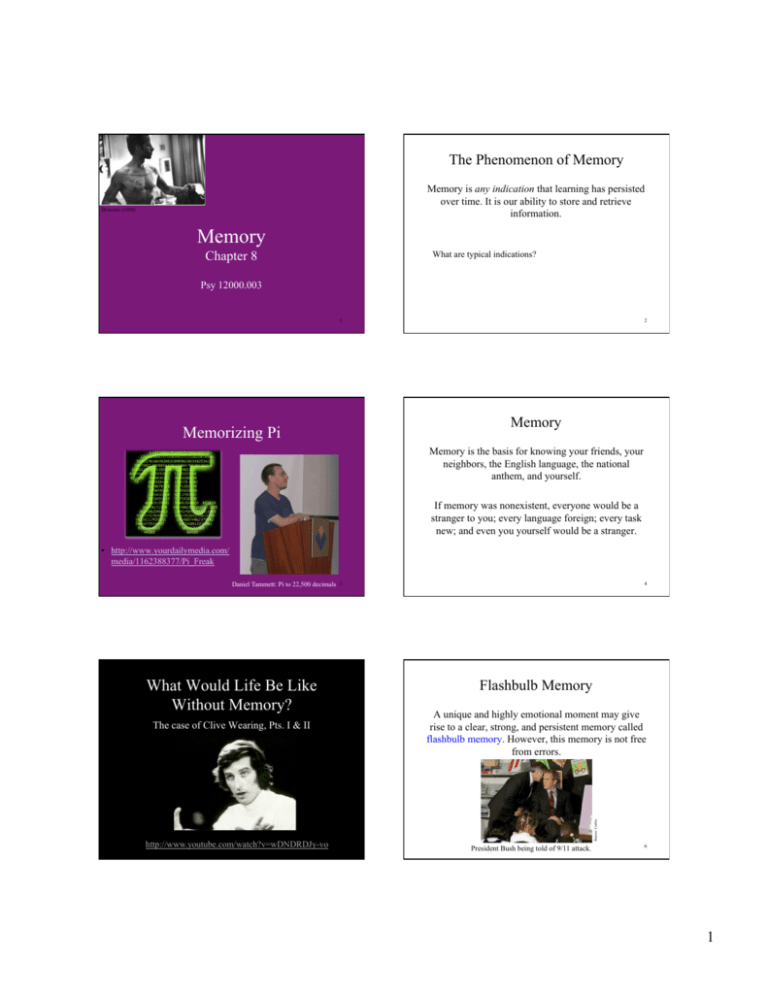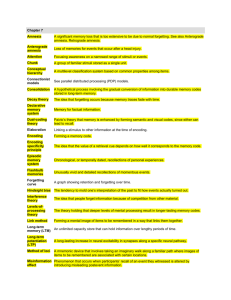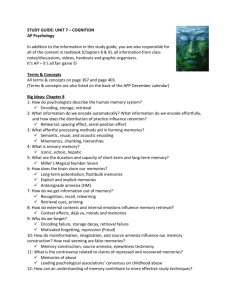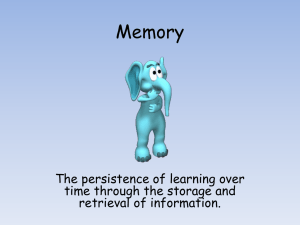
The Phenomenon of Memory
Memory is any indication that learning has persisted
over time. It is our ability to store and retrieve
information.
Memento (2000)
Memory
Chapter 8
What are typical indications?
Psy 12000.003
1
2
Memory
Memorizing Pi
Memory is the basis for knowing your friends, your
neighbors, the English language, the national
anthem, and yourself.
If memory was nonexistent, everyone would be a
stranger to you; every language foreign; every task
new; and even you yourself would be a stranger.
• http://www.yourdailymedia.com/
media/1162388377/Pi_Freak
Daniel Tammett: Pi to 22,500 decimals
3
What Would Life Be Like
Without Memory?
Flashbulb Memory
A unique and highly emotional moment may give
rise to a clear, strong, and persistent memory called
flashbulb memory. However, this memory is not free
from errors.
Ruters/ Corbis
The case of Clive Wearing, Pts. I & II
http://www.youtube.com/watch?v=wDNDRDJy-vo
4
5
President Bush being told of 9/11 attack.
6
1
Information Processing
Stages of Memory
Monitor
(Retrieval)
Sequential Process
7
8
Problems with the Model
Working Memory
Some information skips the first two stages and
enters long-term memory automatically.
Because we cannot focus all the sensory
information in the environment, we select
information (through attention) that is important
to us.
The nature of short-term memory is more
complex.
Alan Baddeley (2002) proposes that working memory contains
auditory and visual processing controlled by the central
executive through an episodic buffer.
3
2
9
Frank Wartenberg/ Picture Press/
Corbis
Disk
(Storage)
Bob Daemmrich/ The Image Works
Keyboard
(Encoding)
Bob Daemmrich/ The Image Works
The Atkinson-Schiffrin (1968) three-stage model of
memory includes a) sensory memory, b) short-term
memory, and c) long-term memory.
1
Encoding: Getting Information In
Automatic Processing
How We Encode
We process an enormous amount of information
effortlessly, such as the following:
Some information (where the dairy section is in
the grocery store) is automatically processed.
However, new or unusual information (friend’s
new cell-phone number) requires attention and
effort.
11
10
Space: While reading a textbook, you
automatically encode the place of a picture on a
page.
Time: We unintentionally note the events that
take place in a day.
Frequency: You effortlessly keep track of things
that happen to you.
12
2
Effortful Processing
Effortful learning usually
requires rehearsal or
conscious repetition.
Ebbinghaus studied
rehearsal by using
nonsense syllables: TUV
YOF GEK XOZ
Hermann Ebbinghaus
(1850-1909)
13
Rehearsal
http://www.isbn3-540-21358-9.de
© Bananastock/ Alamy
Spencer Grant/ Photo Edit
Committing novel
information to memory
requires effort just like
learning a concept from a
textbook. Such processing
leads to durable and
accessible memories.
Rehearsal
Spacing Effect
Distributing rehearsal (spacing effect) is better than
practicing all at once (massed practice). Robert Frost’s
poem could be memorized with fair ease if spread over
time.
The more times the nonsense
syllables were practiced on
Day 1,
the fewer repetitions were
required to remember them
on Day 2.
ACQUAINTED WITH THE NIGHT
Robert Frost
I have been one acquainted with the night.
I have walked out in rain — and back in rain.
I have outwalked the furthest city light.
……
15
Serial Position Effect
TUV
ZOF
GEK
WAV
XOZ
TIK
FUT
WIB
SAR
POZ
REY
GIJ
16
Memory Effects
Primacy effect
1.
2.
3.
4.
5.
6.
7.
8.
9.
10.
11.
12.
14
Next-in-line-Effect:
When you are so anxious about being next
that you cannot remember what the person
just before you in line says, but you can recall
what other people well before or after you
say.
Better recall
Poor recall
Better recall
Recency effect
17
18
3
Encoding Meaning
What We Encode
“Whale”
Encoding by meaning
Encoding by images
Encoding by organization
Q: Did the word begin
with a capital letter?
Structural
Encoding
Shallow
Q: Did the word rhyme
with the word
“weight”?
Phonemic
Encoding
Intermediate
Q: Would the word fit
in the sentence?
He met a __________
in the street.
Semantic
Encoding
Deep
19
20
Craik and Lockhart (1972)
Visual Encoding
Results
Mental pictures (imagery) are a powerful aid to
effortful processing, especially when combined with
semantic encoding.
Both photos: Ho/AP Photo
21
Showing adverse effects of tanning and smoking
in a picture may be more powerful than simply talking about it.
Mnemonics
22
Method of Loci
Imagery is at the heart of many memory aids.
Mnemonic techniques use vivid imagery in aiding
memory.
1. Method of Loci
2. Link Method
23
List of Items
Imagined Locations
Charcoal
Pens
Bed Sheets
Hammer
.
.
.
Rug
Backyard
Study
Bedroom
Garage
.
.
.
Living Room
24
4
Link Method
List of Items
Organizing Information for Encoding
http://www.youtube.com/watch?
v=9NROegsMqNc
Newspaper
Shaving cream
Pen
Umbrella
.
.
.
Lamp
Break down complex information into broad
concepts and further subdivide them into categories
and subcategories.
1. Chunking
2. Hierarchy
Involves forming a mental image of items to be
remembered in a way that links them together.
25
26
Chunking
Hierarchy
Organizing items into a familiar, manageable unit.
Try to remember the numbers below.
Complex information broken down into broad
concepts and further subdivided into categories and
subcategories.
1-7-7-6-1-4-9-2-1-8-1-2-1-9-4-1
If you are well versed with American history,
chunk the numbers together and see if you can
recall them better. 1776 1492 1812 1941.
27
Chunking
28
Encoding Summarized in a Hierarchy
Acronyms are another way of chunking information
to remember it (these are also mnemonics).
HOMES = Huron, Ontario, Michigan, Erie, Superior
PEMDAS = Parentheses, Exponent, Multiply, Divide, Add, Subtract
ROY G. BIV = Red, Orange, Yellow, Green, Blue, Indigo, Violet
OCEAN = Openness, Conscientiousness, Extraversion, Agreeableness,
Neuroticism (also CANOE)
29
30
5
Sensory Memory
Storage: Retaining Information
Storage is at the heart of memory. Three stores
of memory are shown below:
Sensory
Memory
Working
Memory
Sensory
Memory
Long-term
Memory
Working
Memory
Long-term
Memory
Encoding
Events
Encoding
Encoding
Retrieval
Events
Encoding
Retrieval
Retrieval
Retrieval
31
32
Whole Report
Partial Report
Sperling (1960)
R G T
F M Q
L Z S
S X T
J R S
P K Y
“Recall”
RTMZ
(44% recall)
Low Tone
“Recall”
JRS
(100% recall)
Medium Tone
High Tone
50 ms (1/20 second)
50 ms (1/20 second)
The exposure time for the stimulus is so small
that items cannot be rehearsed.
Sperling (1960) argued that sensory memory capacity was
larger than what was originally thought.
33
34
Time Delay
Sensory Memory
A D I
N L V
O G H
Low Tone
Time
Delay
Medium Tone
High Tone
“Recall”
N__
(33% recall)
50 ms (1/20 second)
Percent Recognized
The longer the delay, the greater the memory loss.
80
60
40
20
0.15
35
0.30
0.50
Time (Seconds)
1.00
36
6
Sensory Memories
Working Memory
The duration of sensory memory varies for the
different senses.
Sensory
Memory
Working
Memory
Long-term
Memory
Encoding
Iconic
0.5 sec. long
Events
Encoding
Retrieval
Echoic
3-4 sec. long
Retrieval
Hepatic
< 1 sec. long
37
38
Capacity
Working Memory
Working memory, the new name for short-term
memory, has a limited capacity (7±2) and a short
duration (20 seconds).
The Magical Number Seven, Plus or
Minus Two: Some Limits on Our
Capacity for Processing Information
(1956).
Ready?
MUTGIKTLRSYP
You should be able to
recall 7±2 letters.
Sir George Hamilton observed that he could accurately remember up
to 7 beans thrown on the floor. If there were more beans, he guessed.
George Miller
39
40
Chunking
Duration
The capacity of the working memory may be
increased by “Chunking.”
Brown/Peterson and Peterson (1958/1959) measured
the duration of working memory by manipulating
rehearsal.
CHJ
MKT
HIJ
547
F-B-I-T-W-A-C-I-A-I-B-M
FBI TWA CIA IBM
4 chunks
41
547
544
541
…
The duration of the working memory is about 20
sec.
CH??
42
7
Long-Term Memory
Working Memory Duration
Sensory
Memory
Working
Memory
Long-term
Memory
Encoding
Also called, “the
forgetting curve”
Events
Encoding
Retrieval
Retrieval
43
Long-Term Memory
44
Memory Feats
Unlimited capacity store. Estimates on capacity range
from 1000 billion to 1,000,000 billion bits of
information (Landauer, 1986).
R.J. Erwin/ Photo Researchers
The Clark’s nutcracker can locate 6,000 caches of
buried pine seeds during winter and spring.
45
Memory Stores
46
Shallow vs. Deep Processing
Feature
Sensory
Memory
Working
Memory
LTM
Encoding
Copy
Phonemic
Semantic
Capacity
Unlimited
7±2 Chunks
Very Large
Duration
0.25 sec.
20 sec.
Years
• Deeply processed information is better
remembered than shallowly processed information
• Shallow instructions:
– look at word list and determine if each word has a
capital letter in it or not
– Is the word a verb or noun?
– What rhymes with each word?
• Deep instructions:
47
– What is the meaning of each word? Does each word
have more than one meaning?
– Relate each word to yourself
48
8
Storing Memories in the Brain
Adaptive Memory
• Another example of evolutionary psychology’s influence; this time on
memory.
Through electrical stimulation of the brain,
Wilder Penfield (1967) concluded that old
memories were etched into the brain.
Loftus and Loftus (1980) reviewed Penfield's
data and showed that only a handful of brain
stimulated patients reported flashbacks.
Using rats, Lashley (1950) suggested that even
after removing parts of the brain, the animals
retain partial memory of the maze.
49
Synaptic Changes
50
Synaptic Changes
When Aplysia Californica, (a type of large sea slug), are
threatened, they release clouds of ink to blind the attacker.
Thus, this ink-release behavior can be conditioned, and
neurobiologists can study changes that results.
Kandel and Schwartz (1982) showed that serotonin release
from neurons increased after conditioning.
Therefore, a biological trace that represents memory.
51
Stress Hormones & Memory
Both Photos: From N. Toni et al., Nature, 402, Nov. 25 1999. Courtesy of Dominique Muller
Photo: Scientific American
Long-Term Potentiation
(LTP) refers to synaptic
enhancement after learning
(Lynch, 2002). An increase
in neurotransmitter release
or receptors on the
receiving neuron indicates
strengthening of synapses.
52
Neurogenesis
Heightened emotions (stress-related or otherwise) make for
stronger memories (but still vulnerable to misinformation
effects).
Prolonged stress may disrupt memory.
Scott Barbour/ Getty Images
53
• The creation of new
neurons, even in
adulthood, as a result
of positive stress and
learning responses to
novel information/
stimuli
• Previously thought not
to occur in adults
E. Gould (2010)
54
9
Hippocampus
Storing Implicit & Explicit Memories
Hippocampus – a neural center in the limbic
system that processes explicit memories.
Explicit Memory refers to facts and experiences that one can
consciously know and declare. Implicit memory involves
learning an action while the individual does not know or
declare what she knows.
Weidenfield & Nicolson archives
55
56
Anterograde Amnesia
Implicit Memory
After losing his hippocampus in surgery, patient Henry
M. (HM) remembered everything before the operation
but cannot make new memories. We call this anterograde
amnesia.
HM is unable to make new memories that are
declarative (explicit), but he can form new
memories that are procedural (implicit).
Anterograde
Amnesia
(HM)
Memory Intact
No New Memories
Surgery
A
57
B
C
HM learned the Tower of Hanoi (game) after his surgery. Each time he
plays it, he is unable to remember the fact that he has already played the
game.
58
Cerebellum
Retrieval: Getting Information Out
Cerebellum – a neural center in the hindbrain
that processes implicit memories.
Retrieval refers to getting information out of the
memory store.
Spanky’s Yearbook Archive
Spanky’s Yearbook Archive
59
60
10
Measures of Memory
Measures of Memory
In recognition, the person must identify an item
amongst other choices. (A multiple-choice test
requires recognition.)
In recall, the person must retrieve information using
effort. (A fill-in-the blank test requires recall.)
1. The capital of France is ______.
1. Name the capital of France.
a.
b.
c.
d.
Brussels
Rome
London
Paris
61
62
Measures of Memory
Retrieval Cues
In relearning, the individual shows how much time
(or effort) is saved when learning material for the
second time.
Memories are held in storage by a web of
associations. These associations are like anchors that
help retrieve memory.
List
List
Jet
Dagger
Tree
Kite
…
Silk
Frog
Ring
Jet
Dagger
Tree
Kite
…
Silk
Frog
Ring
It took 10 trials
to learn this list
1 day later
Saving
It took 5 trials
to learn the list
Relearning
Trials
X 100
Relearning
Trials
Original
Trials
10
5
10
fire
smoke
X 100
water
smell
Fire Truck
heat
hose
truck
red
50%
63
64
Priming
Context Effects
To retrieve a specific memory from the web of
associations, you must first activate one of the
strands that leads to it. This process is called priming.
Scuba divers recall more words underwater if they
learned the list underwater, while they recall more words
on land if they learned that list on land (Godden &
Baddeley, 1975).
Fred McConnaughey/ Photo Researchers
65
66
11
Déja Vu
Context Effects
Déja Vu means “I've experienced this before.” Cues
from the current situation may unconsciously
trigger retrieval of an earlier similar experience.
After learning to move a mobile by kicking, infants
most strongly respond when retested in the same
context rather than in a different context (Butler &
Rovee-Collier, 1989).
Courtesy of Carolyn Rovee-Collier,
Rutgers University
© The New Yorker Collection, 1990. Leo Cullum from
cartoonbank.com. All Rights Reserved
67
Moods and Memories
Forgetting
We usually recall experiences that are consistent with
our current mood. Emotions, or moods, serve as
retrieval cues.
An inability to retrieve information due to poor
encoding, storage, or retrieval.
Jorgen Schytte/ Still Pictures
69
Encoding Failure
68
70
Which penny is real?
We cannot remember what we do not encode.
71
72
12
Storage Decay
Retaining Spanish
Poor durability of stored memories leads to
their decay. Ebbinghaus showed this with his
forgetting curve.
Bahrick (1984) showed a similar pattern of forgetting
and retaining over 50 years.
Andrew Holbrooke/ Corbis
73
74
Interference
Retrieval Failure
Although the information is retained in the memory
store, it cannot be accessed.
Older learning may interfere with learning new material (proactive interference).
Learning new information may disrupt retrieval of old information (retroactive interference).
Retrieval of information may interfere with other retrieval (output interference)
French learned
Spanish
learnedbeforehand,
afterwards, interferes
interferes proactively
retroactivelywith
witha aSpanish
Frenchexam
exam
Psy 12000
Tip-of-the-tongue (TOT) is a retrieval failure phenomenon.
75
76
Motivated Forgetting
Retroactive Interference
Sleep prevents retroactive interference. Therefore, it
leads to better recall.
Motivated Forgetting: People
unknowingly revise their
memories.
Repression: A defense
mechanism that banishes
anxiety-arousing thoughts,
feelings, and memories from
consciousness.
Culver Pictures
Suppression: Consciously
inhibiting unwanted thoughts.
Sigmund Freud
77
78
13
Why do we forget?
Memory Construction
While tapping our memories, we filter or fill in
missing pieces of information to make our recall
more coherent.
Forgetting can occur at
any memory stage. We
filter, alter, or lose much
information during these
stages.
Misinformation Effect: Incorporating misleading
information into one's memory of an event.
79
Misinformation and Imagination Effects
80
Misinformation
Group A: How fast were the cars going
when they hit each other?
Eyewitnesses reconstruct their memories when
questioned about the event.
Group B: How fast were the cars going
when they smashed into each
other?
Depiction of the actual accident.
81
Memory Construction
Source Amnesia
A week later they were asked: Was there any broken
glass? Group B (smashed into) reported more broken
glass than Group A (hit).
Source Amnesia: Attributing an event to the wrong
source that we experienced, heard, read, or imagined
(misattribution).
(sometimes called unconscious transference)
50
Broken Glass? (%)
82
40
32
30
20
14
10
0
Group A (hit)
Group B (Smashed into)
Verb
83
84
14
Discerning True & False Memories
False Memories
Just like true perception and illusion, real memories
and memories that seem real are difficult to discern.
Repressed or Constructed?
Some adults actually do forget childhood episodes of
abuse.
© Simon Niedsenthal
False Memory Syndrome
A condition in which a person’s identity and
relationships center around a false but strongly
believed memory of a traumatic experience, which is
sometimes induced by well-meaning therapists.
When students formed a happy or angry memory of
morphed (computer blended) faces, they made
the (computer assisted) faces (a), either happier or (b) angrier.
85
86
Children’s Eyewitness Recall
Memories of Abuse
Children’s eyewitness recall can be unreliable if
leading questions are posed. However, if cognitive
interviews are neutrally worded, the accuracy of
their recall increases. In cases of sexual abuse, this
usually suggests a lower percentage of abuse.
Are memories of abuse repressed or constructed?
Many psychotherapists believe that early childhood
sexual abuse results in repressed memories.
However, other psychologists question such beliefs
and think that such memories may be constructed.
87
88
Experimentally CreatingFalse
Memories
Constructed Memories
Loftus’ research shows that if false memories (lost at
the mall or drowned in a lake) are implanted in
individuals, they construct (fabricate) their memories.
Don Shrubshell
89
http://www.youtube.com/watch?v=eHPQYQ3NOjg
90
15
Consensus on Childhood Abuse
Prospective Memory
Leading psychological associations of the world agree
on the following concerning childhood sexual abuse:
• Remembering TO DO something, and when
Injustice happens.
Incest and other sexual abuse happens.
People may forget.
Recovered memories are commonplace.
Recovered memories under hypnosis or drugs are
unreliable.
Memories of things happening before 3 years of age are
unreliable.
Memories, whether real or false, are emotionally
upsetting.
91
Improving Memory
Improving Memory
Study repeatedly to boost long-term recall.
Spend more time rehearsing or actively thinking
about the material.
Make material personally meaningful.
Use mnemonic devices:
associate with peg words — something already stored
make up a story
chunk — acronyms
93
5. Activate retrieval cues — mentally recreate the
situation and mood.
6. Recall events while they are fresh — before you
encounter misinformation.
7. Minimize interference:
1. Test your own knowledge.
2. Rehearse and then determine what you do not yet
know.
© LWA-Dann Tardiff/ Corbis
92
McDaniel, 2008
94
16










